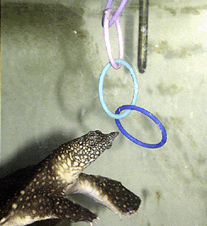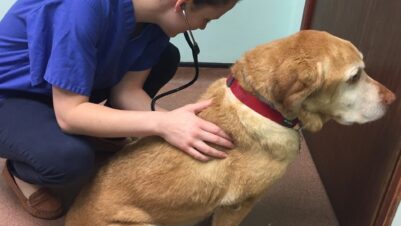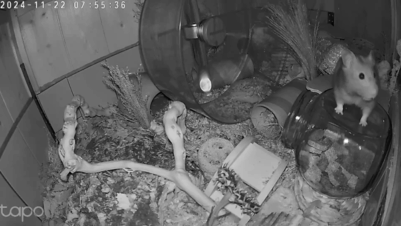If we consider this alongside a dog having a negative experience, such as being seen in clinic when the dog feels unwell or is in pain, including going through a surgery, this negative association with the veterinary environment is heightened. Naturally we can see this exacerbate how a dog may exhibit signs of stress when they are taken to a veterinary practice.
Early intervention and reintroduction of the veterinary practice can be pivotal in minimising and reducing long-term stress associated with veterinary visits
When a dog has had a negative experience at the veterinary practice this can often lead to lifelong fear and anxiety for the individual at every vet trip. Early intervention and reintroduction of the veterinary practice can be pivotal in minimising and reducing long-term stress associated with veterinary visits.
This informs us that we should intervene as quickly as possible to support dogs behaviourally when they visit the vets. There are many factors that can cause stress at the veterinary practice (Edwards et al., 2019; Hernander et al., 2015) and a multitude of behavioural techniques that can be used to reduce fear and anxiety (Lloyd, 2017). Below are some early intervention ideas that can be easy to convey within a veterinary consultation to encourage owners to reintroduce the veterinary environment to dogs that are exhibiting signs of stress.
Reintroduction of the veterinary practice
When we know that a dog has shown signs of stress when they visit the vet, we should think about all future vet visits as being a reintroduction to the veterinary environment for the building of positive associations. This allows a change of mindset for both owners and their dogs to aim to minimise the escalation of any fear and anxiety and allow systematic desensitisation to the veterinary clinic, changing a negative emotional response to a positive emotional response.
Regular non-invasive visits
Regular vet visits that result in non-invasive handling can be incredibly useful to create a positive experience in visiting the veterinary practice. For some individuals this may need to start with car-park visits to create some positive associations before building up to going into the building.
It is essential that these visits are very much dog-led in that they don’t force the dog into an area they would choose to move away from, and that they allow the dog to move around without too much restriction and confinement
It is essential that these visits are very much dog-led in that they don’t force the dog into an area they would choose to move away from, and that they allow the dog to move around without too much restriction and confinement. Ideally this can all be done while providing some very positive enrichment-based activities such as a lick mat, stuffed Kong or snuffle mat. This will then encourage naturally relaxing behaviours while forming strong positive associations with their visit.
These visits should be done often, usually around once a week, to really build up some momentum in teaching a new emotional response to the veterinary practice.
For those dogs that enjoy seeing and meeting new humans, these visits can include greeting reception or kennel staff for a few food rewards to further build up positive associations. For those that do not enjoy seeing and meeting new humans, these visits should include simply being ignored by the humans while exploring the reception and waiting areas and enjoying their enrichment activity.
It is vital during these visits to avoid putting the dog in a situation where they react fearfully or anxiously. If they do start to become too overly stressed, then the session should be stopped and a way to reduce the level of exposure for the dog be devised for the next visit.
Muzzle training
Muzzle training at home is an essential part of preparing to reintroduce formal handling and veterinary visits
Muzzle training at home is an essential part of preparing to reintroduce formal handling and veterinary visits. Ideally, we want all dogs to be able to happily and comfortably wear a muzzle so that if it is ever required it does not form a stressful experience for the dog.
If they have never been muzzle trained and are then required to wear a muzzle due to an injury that needs treatment, this will add more stress to the situation. If they have been muzzle trained well then one can be put on quickly and easily without excess restraint and force, and treatment can be completed.
Muzzle training should constitute building up a strong positive association for the dog with their muzzle slowly and gradually until they are happy to wear it. This can be done through lots of short training sessions, starting with repetitions of being given food rewards when seeing the muzzle, building up to putting the dog’s nose in the muzzle for food rewards, and then gradually working towards greater lengths of time in the muzzle until the dog can happily wear it.
If it is required for safety, all future vet trips can then be done with the dog wearing a muzzle without it adding extra stress for the dog.
Handling training at home
Steps should then be taken to desensitise the dog to formal handling through gentle exposure to being touched by the owner before building up to being able to manipulate various parts of the body
It is very useful for owners to practise some formal handling at home with their dogs while preparing them to visit the vets. This formal handling should include the dogs seeing, smelling and feeling husbandry tools that they are likely to come across. Some of these tools include nail clippers, stethoscopes, toy syringes, empty eye/ear dropper bottles and a bright torch-type light, to name a few.
It is common for owners to understand the importance of touching their dogs regularly at home to assist with handling situations but what is often missed from this are the formal aspects of husbandry procedures, including equipment that veterinary personnel may need to use. Within the training scenario the dog can be carefully exposed to these items of equipment so that they are able to relax and feel more confident with them.
It is useful to rehearse the dog moving into a sit and stand position for handling which can be done through obedience training. This allows for access to certain types of handling and manipulation when being examined.
Steps should then be taken to desensitise the dog to formal handling through gentle exposure to being touched by the owner before building up to being able to manipulate various parts of the body. Lastly, this handling training should include gently touching the dog with the items of equipment at various points across the body, for example the stethoscope on the chest or the syringe on the neck.
The use of anxiolytic medication
If a dog presents to the veterinary surgery that is highly anxious or fearful then the veterinary surgeon may wish to discuss with the owner the use of anxiolytic medication before and during any further vet visits, while the reintroduction programme is taking place. This should support the dog in reducing stress levels and minimising negative associations (Erickson et al., 2021) in the short term while behavioural intervention can take place.
Seek the help of a clinical animal behaviourist
If a dog is suffering from extreme fear or anxiety when visiting the vets, then immediate referral to a clinical animal behaviourist should be considered so that a full behaviour programme can be implemented. This is particularly important if the dog is aggressive towards other dogs, animals or humans within the veterinary practice or is so stressed that it cannot eat.







